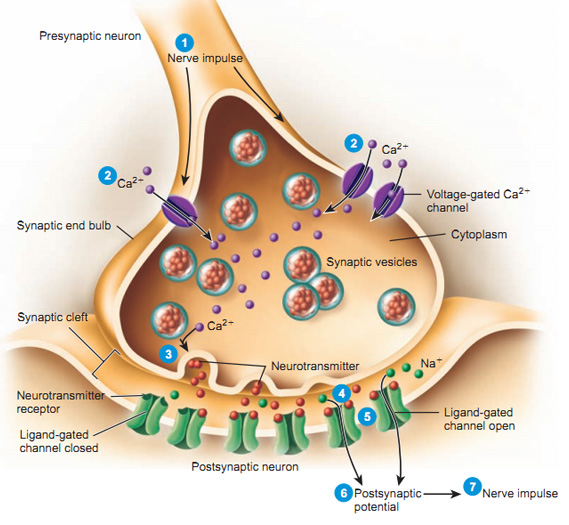Synaptic transmission: Difference between revisions
No edit summary |
m grammatical corrections and added links |
||
| Line 1: | Line 1: | ||
Electrical transmission occurs when an action potential reaches an [[ | Electrical transmission occurs when an [[Action_potential|action potential ]]reaches an [[Axon|axon]] terminal, this depolarises the [[Pre synaptic membrane|presynaptic membrane]]. Voltage gated Ca<sup>2+</sup> channels on the[[Presynaptic_membrane|presynaptic membrane]] open in response to this [[Depolarisation|depolarisation]]. Ca<sup>2+</sup> enters the axon terminal down a[[Concentration_Gradient|concentration gradient]] through these open channels. This causes the [[Vesicles|vesicles]] containing the neurotransmitter [[Acetylcholine|acetylcholine ]]to migrate towards the [[Presynaptic_membrane|presynaptic membrane]]. These vesicles fuse with the [[Presynaptic_membrane|presynaptic membrane]], and [[Acetylcholine|acetylcholine]] molecules are released into the [[Synaptic_cleft|synaptic cleft]] by the process of [[Exocytosis|exocytosis]]. [[Acetylcholine|Acetylcholine]] molecules diffuse across the [[Synaptic_cleft|synaptic cleft]] and bind to receptors on the [[Postsynaptic_membrane|postsynaptic membrane]]. The binding of [[Acetylcholine|acetylcholine]] causes ligand gated Na<sup>+</sup> channels to open and subsequently Na<sup>+</sup> rushes into the[[Postsynaptic_membrane|postsynaptic membrane]], depolarising it to the [[Threshold_potential|threshold potential]], therefore setting off an [[Action potential|action potential]] in the [[postsynaptic neurone|postsynaptic neurone]]. | ||
<br> | <br> | ||
[[Image:Synapse.jpg]]<br><ref>Antranik (2012) Synaptic Transmission by Somatic Motorneurons, [Online], Available: http://antranik.org/synaptic-transmission-by-somatic-motorneurons/ accessed [27 Nov 2013].</ref><br> | [[Image:Synapse.jpg]]<br><ref>Antranik (2012) Synaptic Transmission by Somatic Motorneurons, [Online], Available: http://antranik.org/synaptic-transmission-by-somatic-motorneurons/ accessed [27 Nov 2013].</ref><br> | ||
=== References === | === References === | ||
<references /> | <references /> | ||
Revision as of 14:30, 20 October 2017
Electrical transmission occurs when an action potential reaches an axon terminal, this depolarises the presynaptic membrane. Voltage gated Ca2+ channels on thepresynaptic membrane open in response to this depolarisation. Ca2+ enters the axon terminal down aconcentration gradient through these open channels. This causes the vesicles containing the neurotransmitter acetylcholine to migrate towards the presynaptic membrane. These vesicles fuse with the presynaptic membrane, and acetylcholine molecules are released into the synaptic cleft by the process of exocytosis. Acetylcholine molecules diffuse across the synaptic cleft and bind to receptors on the postsynaptic membrane. The binding of acetylcholine causes ligand gated Na+ channels to open and subsequently Na+ rushes into thepostsynaptic membrane, depolarising it to the threshold potential, therefore setting off an action potential in the postsynaptic neurone.
References
- ↑ Antranik (2012) Synaptic Transmission by Somatic Motorneurons, [Online], Available: http://antranik.org/synaptic-transmission-by-somatic-motorneurons/ accessed [27 Nov 2013].
